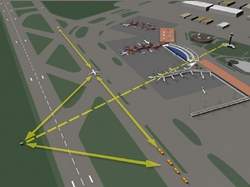Embry-Riddle, UPS Get Together
 A new aircraft collision-avoidance system that is
being hailed as a breakthrough equal to the invention of radar will
be installed this year at Embry-Riddle Aeronautical University. The
university’s acquisition of Automatic Dependent
Surveillance-Broadcast (ADS-B) technology from UPS Aviation
Technologies promises to be the start of a revolution in the way
general aviation aircraft are controlled in flight.
A new aircraft collision-avoidance system that is
being hailed as a breakthrough equal to the invention of radar will
be installed this year at Embry-Riddle Aeronautical University. The
university’s acquisition of Automatic Dependent
Surveillance-Broadcast (ADS-B) technology from UPS Aviation
Technologies promises to be the start of a revolution in the way
general aviation aircraft are controlled in flight.
By giving pilots of small aircraft unprecedented awareness of
their surroundings, the system decreases hazards associated with
traffic, weather, and terrain – the three greatest threats to
general aviation aircraft.
The technology, embodied in MX20 multi-function displays and
DL90 universal access transceivers from UPS Aviation Technologies,
will be installed in more than 100 of Embry-Riddle’s training
aircraft later this year at its campuses in Prescott (AZ) and
Daytona Beach (FL).

ADS-B relies on GPS to determine an aircraft’s precise
location in space. The position is then converted into a digital
code, which is combined with other information such as the type of
aircraft, its speed, its flight number, and whether it is turning,
climbing or descending. This information is updated every second
and broadcast from the aircraft on a discreet frequency.
Other aircraft and ground stations within 150 miles receive the
broadcasts. Pilots in the air see traffic on a cockpit display,
while controllers on the ground see the ADS-B targets on their
regular traffic display screen along with other radar targets.
 Unlike conventional radar, ADS-B works at low
altitudes and on the ground so that it can be used to monitor
traffic on airport runways. It is effective in remote or
mountainous areas where radar coverage is limited or nonexistent.
One of its greatest benefits is that it gives the same information
to pilots in aircraft cockpits and to ground controllers, allowing
them both to "see" the same data.
Unlike conventional radar, ADS-B works at low
altitudes and on the ground so that it can be used to monitor
traffic on airport runways. It is effective in remote or
mountainous areas where radar coverage is limited or nonexistent.
One of its greatest benefits is that it gives the same information
to pilots in aircraft cockpits and to ground controllers, allowing
them both to "see" the same data.
The cockpit-based avionics also can receive uplinks of weather
and air traffic radar data from ground stations with universal
access transceivers (UAT). These uplinks will later include
information about temporary flight restrictions and special-use
airspace status.
As part of its Safe Flight 21 Program, the Federal Aviation
Administration plans to construct UAT-equipped ground stations in
Arizona and Florida early next year to support Embry-Riddle’s
aircraft and permit the university to track its fleets. The ground
stations will supply weather and traffic information not only to
planes flown by Embry-Riddle students, but to any aircraft equipped
with the ADS-B avionics.
"This equipment, with its phenomenal capability, is finally
affordable for the general aviation pilot," says Sean Jeralds, who
chairs Embry-Riddle’s flight training program at Prescott.
"Successful implementation in Arizona and Florida could convince
the FAA to complete the installation of ground stations throughout
the country."
The installation of ground stations could jump-start a change in
the way general aviation flies if other pilots in the area begin to
take advantage of the same information.
 "We are extremely excited about working with
Embry-Riddle," says John Macnab, general manager of UPS Aviation
Technologies. "We believe our ADS-B avionics will be a great
benefit to their flight school operations and is a significant step
towards making the benefits of ADS-B and UAT data link
"We are extremely excited about working with
Embry-Riddle," says John Macnab, general manager of UPS Aviation
Technologies. "We believe our ADS-B avionics will be a great
benefit to their flight school operations and is a significant step
towards making the benefits of ADS-B and UAT data link
available to general aviation."
The FAA recently issued a solicitation for new UAT ground
stations for Alaska, with an option to buy enough units for the
entire United States.
 ANN's Daily Aero-Linx (04.17.24)
ANN's Daily Aero-Linx (04.17.24) ANN's Daily Aero-Term (04.17.24): Jamming
ANN's Daily Aero-Term (04.17.24): Jamming ANN's Daily Aero-Linx (04.18.24)
ANN's Daily Aero-Linx (04.18.24) Aero-News: Quote of the Day (04.18.24)
Aero-News: Quote of the Day (04.18.24) ANN's Daily Aero-Term (04.18.24): Hold-In-Lieu Of Procedure Turn
ANN's Daily Aero-Term (04.18.24): Hold-In-Lieu Of Procedure Turn






